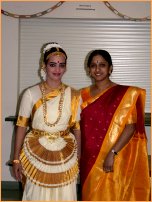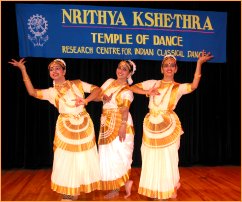
|
 |

|
 |
Mohiniattam in Missouri by Anuradha Chellappa, St.Louis, Missouri e-mail: anuchellappa@yahoo.com March 7, 2003 |
| Just
two months after I reached Edwardsville, Illinois, to start on my M.S in
Physics, our campus Indian Student Association had an "India Night" and
along with an enthusiastic friend Sneha, I presented a thillana in Bharatanatyam
(from what I recalled, having learnt Bharatanatyam for a brief period in
Madras). The next year, the same event was planned, but I had no idea what
to dance, although I really wanted to!
One day, Sneha's friend, - another Indian student, casually mentioned that someone named Smitha Rajan, who was the grand-daughter of "some Kalamandalam Kalyanikuttiamma" was in St. Louis and that she was a big dancer. (St. Louis is in Missouri, and is a half hour drive from Edwardsville). My antenna picked that up - "Kalamandalam Kalyanikuttiamma" - wasn't she the grand old lady - the "Mother of Mohiniattam"? I knew that this determined lady had contributed immensely, much more than anyone else, to this dance form. Any girl born in her family had to be a Mohiniattam dancer! So it was with a lot of excitement and eagerness that Sneha and I called up Smitha Rajan, and visited her the next day. My heart was beating fast, my thoughts were racing - I was going to meet this person who was fortunate enough to be the granddaughter of such a great person. How should I talk? What should I say? We were greeted by a very down-to-earth, simple looking young lady, devoted wife and loving mother of two little boys. We told her that we wanted to present a "classical" dance item for our college program and asked if she could help us. She was willing and she composed, with ease, a piece in Bharatanatyam for us, which we practiced and danced. The show was over, but my heart kept wondering - could I learn from her? And I wanted to learn Mohiniattam! Believe me, I had never seen a full-length Mohiniattam recital! I grew up in the "cultural capital of the South" - at Madras, which was super-saturated with Bharatanatyam! From the very, very few Mohiniattam dance items that I did recall watching, I remembered the extremely graceful movements and the simple yet grand costume.  And the fact that Smitha was Kalyanikuttiamma's granddaughter - that settled it - I wanted to learn Mohiniattam from her! So when Smitha came back after her India trip that year, Sneha and I again went to her home, and as I bowed down before her and touched her feet, offering a dakshina, the unspoken words were: "Please help me learn Mohiniattam". I felt so very lucky to have found a teacher like her - someone who started dancing much before she went to school! Smitha's grandfather was one of the most talented and popular Kathakali exponents of his time. How wonderful to grow up amidst such talent, amidst all that choreographing, practice sessions, rehearsals...!  I remember how happy and enthusiastic she was (and has always been) about our class! We started off with the adavus. Mohiniattam is very graceful; but not at all easy, I thought at first! I remember - I used to feel really tired (and hungry!) after each class! After the first few weeks, my body slowly began to get accustomed to the basic "araimandi" position. We kept hearing this: "yatho hasta thatho drishti; yatho drishti thatho manah; yatho manah thatho bhava; yatho bhava thatho rasa....". We also repeatedly heard about this - "flow" in movements! Mohiniattam is all about fluidity and continuity in movement - no jerky starts or abrupt ends! I even noticed that in a song, the jathis were seamlessly placed alongside the words - in the very same raga, so that as the singer shifted unobtrusively from jathi to the words, the dancer too glided from jathi to abhinaya! Our first item was the "cholkettu" and I felt so very happy to be learning a full item now! (Cholkettu is a collection of "chollu"s, that's all! with a small little prayer in the end). Meantime, we had our first chance to watch Smitha present an item for the local Malayali association. She was going to present a dance for the Thyagaraja song "Ksheera sagara shayana" in Devagandhari. Anyone who has heard that song will agree with me that even that very first line - the pallavi, is enough to knock us to a different plane!! I loved that kriti! And now, here was this visual presentation of that composition! When Smitha donned the alluring off-white and golden Mohiniattam costume, she had transformed into a different person - her presence seemed so arresting and powerful. I watched awe-struck, as Smitha explained, with her flawless abhinaya, the Gajendra moksha story. As the elephant king cried out to Vishnu to save him, I felt a choking in my throat. But more was to come. This time it was Draupadi's story. And as I witnessed Draupadi being dragged into the court, as I saw Draupadi asking everyone in the court what had happened and begging for help, as I saw Dushshasana, on orders from Duryodhana, begin disrobing her, I wanted to scream out - "This is totally unjust"! "Why didn't any of you brave men stop this?". I had tears in my eyes. Smitha had now moved on to the next story - that of how Rama saved Sita from Ravana's clutches and brought her back to Ayodhya. Again, I felt deeply emotional. The piece was over, but I was still in the world that I had been transported to! We constantly need to re-inforce the values that we have been taught, the values that we have learnt, the values that we believe in. Go to any lecture - any "kaalakshepam" and we are told that even if we already know the story of the Ramayana or the Mahabharata, there is always something new we can learn each time we listen to it! Classical dance is one such way to reinforce our value system! Although initially it's all about the adavus, the posture, the eye movements, the grace in the body movements, the abhinaya, at another level, it is about being able to focus entirely on that particular moment, and being able to express, within the rules of the dance form and in that way, reaffirm our beliefs. It is a form of upaasana or prayer - an offering to the Lord. To be able to elevate not just oneself by this offering, but also the rasika, the audience, is an ability that takes years and years of devoted training. For me, here in the cultural wilderness that is Missouri, being able to learn Mohiniattam is truly a blessing. Each time I practice an adavu, each time I try out an abhinaya, it's a new and wonderful experience that leaves me refreshed! Each time I attend class, each time Smitha points out another aspect that I need to keep in mind, that opens up an entirely new door! Each time I notice her transform from an "ordinary" woman to the dancer that she is, each time I see the intensity in her eyes when she is trying to teach us - whether it is anger, or compassion, whether it disgust or laughter, I am amazed! It has a lot to do with tuning the mind and full focus! Sometimes, I feel the class is like a meditative session although physically, I have been performing some steps and have been moving around! My music teacher back home in Madras, Smt. Savithri Satyamurti, used to tell us that her guru - the great musicologist Dr. S Ramanathan, always used to say that: "Any person who can talk, can be taught how to sing; any person who can walk, can be taught how to dance" So if you are wondering, there is your answer! If we do not want to delve that deep, we can at least watch some classical dance and take our children to such programs. What a wonderful, precious dance legacy we have! It is our responsibility to do our bit to cherish and preserve this great tradition! Anuradha Chellappa was earlier a Bharatanatyam student of Malathy Thotadri and Usha Raghavan of "Kala Sagara", Chennai. She started learning Mohiniattam from Smitha Rajan when she moved to St.Louis. Anu currently works as an Oracle DBA; she has completed a masters degree in Vaishnavism from the University of Madras; apart from dance and music, her interests include learning Samskritam, reading, hiking, step aerobics and inline skating. |